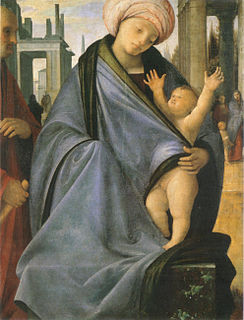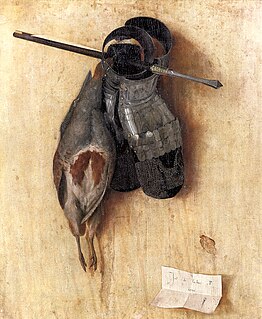 W
WAdoration of the Magi is a 1504 fresco by Perugino in the Oratorio di Santa Maria dei Bianchi in Città della Pieve. It shows the Adoration of the Magi, with an idealised view from Città della Pieve towards Lake Trasimene and Val di Chiana in the background. It is often compared to the Adoration of the Magi in the Sala delle Udienze del Collegio del Cambio in Perugia by Perugino and his studio, which includes areas argued by some art historians to have been painted by a young Raphael.
 W
WThe Adoration of the Magi is a panel painting by Albrecht Dürer (1471-1528), produced under commission by Frederick the Wise for the altar of the Schlosskirche in Wittenberg. It is considered one of Dürer's best and most important works from the period between his first and second trips to Italy. The work is modest in size, just over a metre wide, however it is of great importance in Dürer's oeuvre and in the history of art. Before the production of this work, Dürer's achievements lay largely in his printmaking career, or with his self-portraiture. This work is especially crucial in its distinction of Dürer's difference as he combines a fine balance of northern and Italianate conventions in the work. Heinrich Wölfflin referred to the work as “the first completely lucid painting in the history of German art”.
 W
WThe Diotallevi Madonna is a c.1504 oil on panel painting by Raphael, now in the Bode Museum in Berlin, which it entered in 1841-1842 from marquess Diotallevi's collection in Rimini. Previously attributed to Raphael's teacher Perugino, almost all art historians now attribute it to Raphael, with the exception of Adolfo Venturi who attributed it and parts of Perugino's Madonna della Consolazione to an anonymous "Master of the Diotallevi Madonna".
 W
WThe Garden of Earthly Delights is the modern title given to a triptych oil painting on oak panel painted by the Early Netherlandish master Hieronymus Bosch, between 1490 and 1510, when Bosch was between 40 and 60 years old. It has been housed in the Museo del Prado in Madrid since the year 1939.
 W
WThe Giustiniani Portrait or Portrait of a Young Man is a painting of about 1503-1504 frequently, but not universally, attributed to Giorgione, which is now in the Gemäldegalerie, Berlin.
 W
WMadonna and Child with a Man or Madonna and Child with a Male Figure is an oil painting on panel of c. 1503–04 by Bramantino in the Pinacoteca di Brera in Milan, which it entered in 1896. The painting had previously been in the collection of cardinal Cesare Monti, left to the Archdiocese of Milan in 1650. Its previous provenance is unknown, though its small dimensions suggest that it was intended for private devotion.
 W
WMadonna and Child with St John the Baptist and St Catherine of Alexandria or Mystic Marriage of Saint Catherine with St John the Baptist is a c.1504 oil on panel painting by Andrea Previtali, produced during his youthful years in Giovanni Bellini's studio. Belonging to the sacra conversazione genre, it is now in the sacristy of the church of San Giobbe in Venice, whilst a autograph copy of the work is now in the National Gallery, London. The London work includes a scroll below Mary inscribed + 1504/Andrea Cordelle/Agi dissipulus/iouanis Bellini/pinxit and the number 24, variously interpreted as the artist's age or as his personal symbol using the signus tabellanolis, a technique used by 16th century notaries the better to identify works' and documents' authenticity.
 W
WThe Madonna and Child with St. John the Baptist and a Female Saint or the Giovanelli Sacred Conversation is an oil painting on panel by Giovanni Bellini, dated to before 1504, when its figure of John the Baptist was copied by Andrea Previtali in one of his own paintings. The identity of the female saint to the right is unclear, but she may be Mary Magdalene or Catherine of Alexandria.
 W
WThe Marriage of the Virgin, also known as Lo Sposalizio, is an oil painting by the Italian High Renaissance artist Raphael. Completed in 1504 for the Franciscan church of San Francesco, Città di Castello, the painting depicts a marriage ceremony between Mary and Joseph. It changed hands several times before settling in 1806 at the Pinacoteca di Brera.
 W
WThe Marriage of the Virgin is a painting by the Italian Renaissance master Perugino, although it is now sometimes attributed to his pupil Lo Spagna. It depicts the marriage between Joseph and Mary, and is now in the Musée des Beaux-Arts of Caen, France. Initially commissioned to Pinturicchio for the recently completed cathedral of Perugia, Perugino took over the commission and finished the work around 1500–1504, probably after several periods of stasis.
 W
WThe Portrait of Perugino is a portrait of the Italian Renaissance artist Perugino attributed to his pupil Raphael or to Lorenzo di Credi. It was produced around 1504 and is now in the Uffizi gallery, Florence.
 W
WSt Mark with Saints Leonard and Catherine of Alexandria is an oil painting by Francesco Beccaruzzi. It is preserved in the cathedral in Conegliano, the artist's hometown.
 W
WSt. George or St. George and the Dragon is a small painting by the Italian Renaissance artist Raphael. It is housed in the Louvre in Paris. A later version of the same subject is the St. George in the National Gallery of Art in Washington, D.C.
 W
WStill-Life with Partridge and Gauntlets is a 1504 painting by the Italian painter Jacopo de' Barbari. It measures 52 cm × 42.5 cm and is held by the Alte Pinakothek in Munich. The small oil-on-limewood-panel painting is considered to be one of the earliest examples of a still life painting, and one of the first trompe-l'œil paintings, to be made in Europe since classical antiquity.
 W
WThe Vision of a Knight, also called The Dream of Scipio or Allegory, is a small egg tempera painting on poplar by the Italian Renaissance artist Raphael, finished in 1504–1505. It is in the National Gallery in London. It probably formed a pair with the Three Graces panel, also 17 cm square, now in the Château de Chantilly museum.